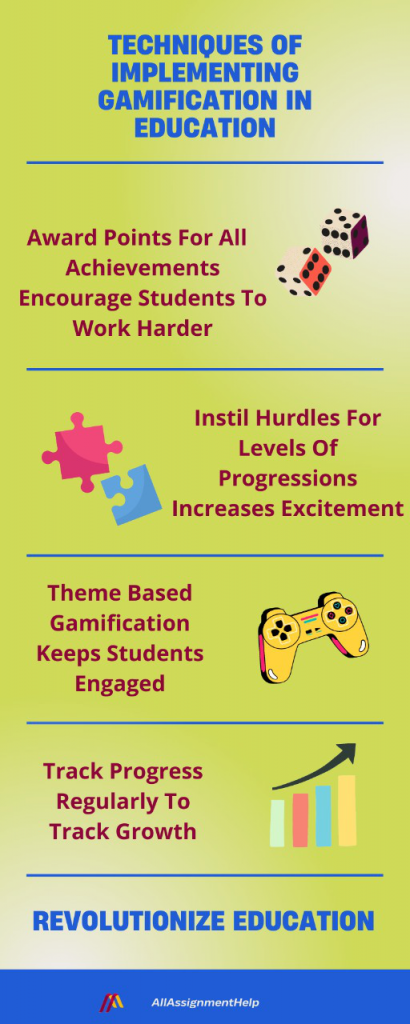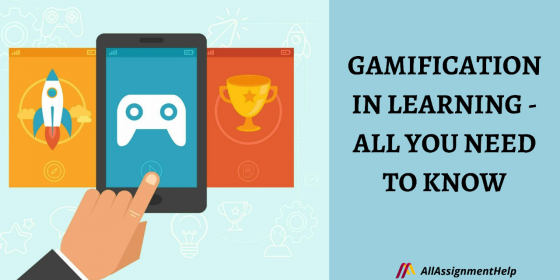Game-Based Learning is a developing trend in a variety of industries, whether it be the education sector or the corporate sector. It has made its mark in the world of education. Popularly known as “Gamification”, game-based Learning has developed a firm place for itself in the education and learning sector. With the inclusion of different components of games in traditional learning, students are now able to put more effort, time, and concentration into learning.
Still, wondering what gamification in learning is? Well! You have come to the right place then. This article will help individuals in understanding what exactly game-based learning is, and how it is impacting the learning experience of students. This article also aims to cover the important benefits of this type of learning, and provides the reader with an elaborate idea regarding the gamification in learning.
It is also important to note, that the article is written by learning experts from AllAssignmentHelp.Com, and this blog in no way intends to create a bias in an individual’s mind. All it aims to do is to help individuals develop a better understanding of the concept.
So, let’s get started with a brief overview of game-based learning.
What Is Gamification in Learning?
Game-Based Learning or Gamification in learning is a revolutionary trend that is building the way students learn. The idea behind gamification of learning is to help students build more concentration and help them increase their engagement in learning activities.
Gamification is the term that stands for the use of game elements and tactics in a non-game context. Gamification in learning means adding game elements to a field or transforming the entity of concern into a game.
In simple words, Gamification in learning implies gamifying the process and experience of learning for the students. Gamification is being used in many niches such as websites, employee training, digital marketing, virtual to-do lists, and a lot more.
When it comes to education, gamification is used to break down the activities, processes, and concepts into a fun format. Elements like scoring points, reaching the next level, acquiring currency, etc. are used to achieve improved learning outcomes through all things fun and games.
Game-Based Learning uses fun and educational games that give the learner an interesting learning opportunity along with some playtime. It also helps in getting more attention from the students as it resonates with the children as if they are playing a game, hence, gamification in learning creates a win-win situation.
Moreover, Gamification has been scientifically proven to improve the learning experience. It releases hormones called endorphins that are produced in the body when our mind is stimulated. While gamification is revolutionizing the world of e-learning for the good, many benefits must be understood to make full use of this process.
Why is Gamification used in Education?
Gamification in learning aims to transform the learning process into a fun element. It is scientifically proven to yield effective learning outcomes. It releases a hormone called endorphin that is produced by our brain when it is stimulated.
Learners learn better when they are completely engaged in what they are learning. Just like every adult is enthralled by his or her favourite movies, children are excited for playing games.
Moreover, the motivation level of students tends to increase. Students will be more inclined towards playing a game than sitting and studying. Gamification targets the soft spot of children and at the same time imparts education to them. There is also a constant burden of homework on students. In such situations they seek online assignment help to ease their burden. Gamification also acts as a stress-reliever in such cases.
Due to gamification, students are intrigued and eager to understand concepts better. They try harder to understand their lessons. This is because they feel the urge to cross the next level in the game, attain higher scores, and win the game. Gamified learning makes use of smartly designed tools that monitor the progress of every child. The learning-based games are designed in a manner that they track the performance of students.
Also Read: Welcoming Social Media for Education in the 21st Century
What is The Impact of Gamification on The Learners?
Every innovative technique comes with its own set of advantages and disadvantages. However, in the case of gamified learning, the advantages overshadow the disadvantages. The positive impact that gamification brings, is much more valuable than its negatives.
When tough and hectic concepts are presented to students in an interactive manner, learning becomes better for them. Boring history chronologies and tough mathematics concepts can be explained to students in an interesting format. So, students feel an incline towards playing educational games. They feel at ease when they can cover their syllabus through short and fun games. Moreover, today’s learners are very active and tech-savvy. They prefer understanding things as fast as possible. Gamification provides accurate learning in a very short period. Another impact on students is that they experience a sense of relief and newness through gamification. These games act as a breather for them between the vast pen-paper learning which cannot be avoided. Also, they learn the spirit of teamwork and healthy competition through game-based learning. This happens since many games are based on team players.
However, some of the negative impacts that gamification brings cannot also be neglected. It is often observed that students ignore subjects which do not involve much-gamified learning. They expect a short-cut path to learning all concepts which cannot be practically possible. Sometimes, it also happens that learners lose the hack of traditional learning which requires long hours of studying.

Techniques For Implementing Gamification in Learning:
While we have learnt a lot about game-based learning till now, let’s cater for another important question. “How can we execute gamification in learning”? Well, before we dive into the answer to this question, there is a note to make. Gamified learning is not restricted only to e-learning. Its benefits are best attained when a combination of online and offline gamification is implied. Let us dig deep into some super-effective strategies to implement game-based learning in teaching pedagogy.
Award Points For All Achievements
The educator must list down the various learning outcomes expected of the students. Apart from learning outcomes, co-curricular accomplishments can also be listed down. The teacher should closely analyse the performance of each child. The child should be awarded for every small task completed or impressive code of conduct. From completing the homework to being regular, this could be anything. This can be done every month. At the end of each month, the teacher can accumulate the game points for students. The child with the maximum points in that month can be awarded a small token of appreciation. A small bar of chocolate, a badge, a book, etc. is some good options.
Instill Hurdles For Levels of Progression
Gamification works on the competitive instinct of the players. In an online game, there must be various virtual barriers, levels, and obstacles. The students will be required to surpass these barriers to progress to the next levels or score more. Each correct answer will add value to their achievement and they can unlock the next phase of learning. In an offline setting, the teacher can innovatively instil barriers. For instance, she or he can become a barrier themselves. They can set certain criteria which will reward students with rewards such as an extra free period, a bonus in attendance, and so on.
Theme Based Gamification
Theme-based learning implies that students are assigned certain roles. The hypothetical roles could be those of a doctor, teacher, nurse, shopkeeper, etc. When students assume these roles in both online and traditional learning, the results are fruitful. Students feel a sense of responsibility and ownership. They utilise their critical thinking and analytical skills to the best of their abilities. Moreover, this is also a practical approach that comes with gamification.
Track Progress Regularly
The teacher must maintain a progress report of students even for game-based learning. While proper analysis is done for pen-paper learning, it is equally crucial for gamification. This is so because it will help to understand whether gamified learning is helping in that domain or not. The necessary changes can be done if needed.
Also Read: Top Seven Trends for eLearning in 2022
Benefits of Gamification:
Gamification in learning has several benefits. From keeping students engaged in the learning process to help them in improving their concentration. Game-Based Learning has truly revolutionized the way students learn and grasp knowledge.
There are many more benefits of game-based learning, some of these are
Game-Based Learning Helps in Developing the Cognitive Abilities in an Adolescent
Using the model of game-based learning in helping with cognitive development will allow an increment in the activity of the various regions of the brain that helps in the adequate development of the brain. Games that are ingrained in the learning methodologies are often called ‘brain games’ that expedite the process of developing the cognitive abilities of the student.
Gamification in Learning Helps in Increasing the Engagement of Students
There have been several types of research that have tested the engagement rate of the students in both the game-based learning scenario and the traditional way of learning scenario. And the results of the study were astounding. The researchers declared that the level of engagement in the gamification in learning scenarios is exponential as compared to the traditional way.
Game-Based Learning Aids in Helping Students in Better Learning
Including gaming elements in the traditional way of learning helps in expediting the learning process. Moreover, it has been tried and tested, that adding gaming elements while teaching in a classroom, has helped students with autism learn and grasp better. Game-based learning made learning faster and better in the classrooms.
Great for E-learning and Enhancing the Range of Online Learning
Game-based learning is not just limited to enhancing the experience in the classroom, in fact, it goes great and is quite compatible with online learning as well. Through the online mode of learning, gamification of the course module could be done in a variety of ways. From having a leaderboard to providing badges. Online learning could be made really fun and engaging through the model of gamification.
Conclusion
Gamification in learning has been one of the greatest developments in education so far. With the onset of the pandemic in 2020, the education sector has undergone many changes and developments, and game-based learning is one of them.
With several benefits, gamification in learning has helped in increasing engagement in learning activities and also has helped in increasing the focus of students on learning activities.
It wouldn’t be wrong to say, that the world is ready to see more advancements in learning, and game-based learning is the right direction to move.
Also Read: Some Awesome Strategies for Studying More Effectively
About Us
All Assignment Help is dedicated assignment help service. We our a team of professional subject matter experts who help students. When students say to us that do my homework for me, we take their pressure into our hands. Our team delivers original, timely and impressive work.
Frequently Asked Questions
| Question: How is Learning Gamified? Answer: Learning could be gamified in a variety of ways. From adding avatars to every student’s profile to assigning scores and maintaining leaderboards, it also has levels and badges for crossing each level. Learning is gamified in a similar fashion as video games are, just the task of activity is more learning-oriented and helps students in being more focused. |
| Question: Are there any tips for making students concentrate more on their studies? Answer: Well! One tip is to make studies fun, and that’s exactly what game-based learning aims to do. If you have trouble making the students concentrate, then game-based learning is the right thing for you. It helps the students in increasing their concentration in their studies, by making the experience of learning more interactive and fun. |
